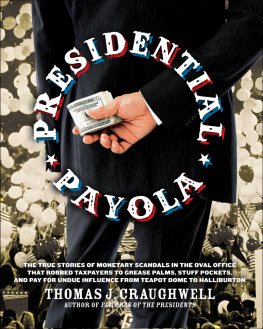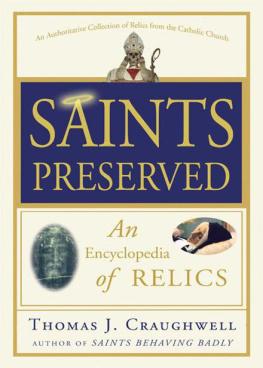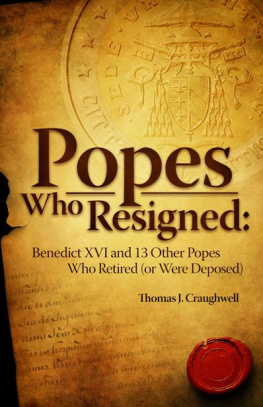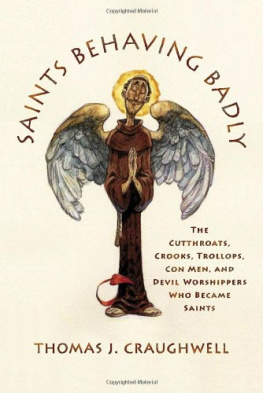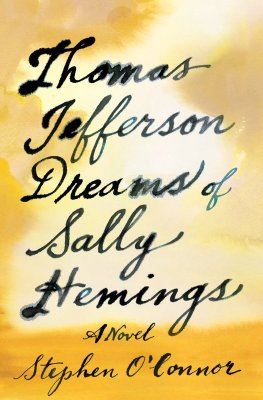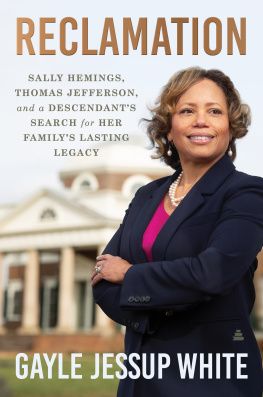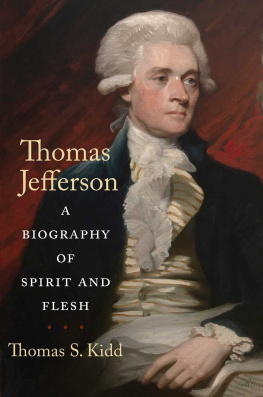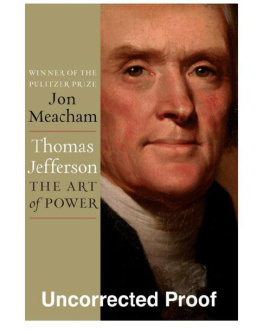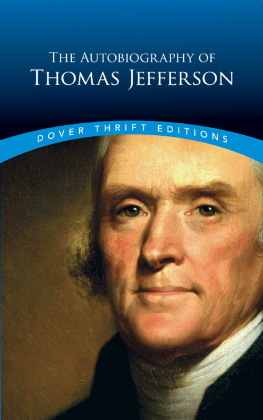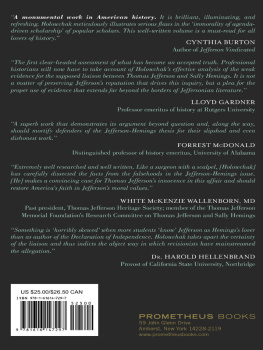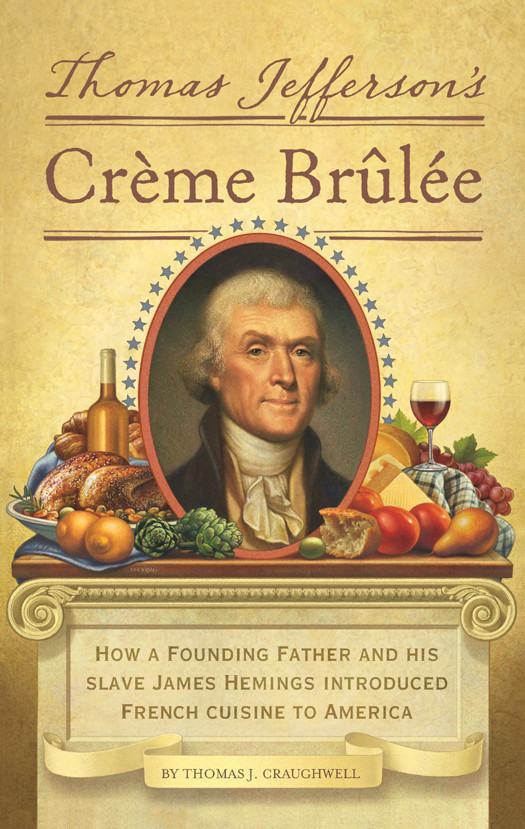Copyright 2012 by Thomas J. Craughwell
All rights reserved. No part of this book may be reproduced in any form without written permission from the publisher.
The publisher wishes to express thanks to Bonnie Coles and the staff of Duplications Services at the Library of Congress, Leah Stearns at Monticello, and the Digital Curation Services department at the University of Virginia Library for their help with images for this book.
Library of Congress Cataloging in Publication Number: 2011946051
eISBN: 978-1-59474-579-9
Designed by Doogie Horner
Cover illustration by Dan Craig
Editorial assistance and photo acquisition by Jane Morley
Production management by John J. McGurk
Quirk Books
215 Church Street
Philadelphia, PA 19106
quirkbooks.com
v3.1
T O MY FRIENDS AND
FELLOW FOOD
HOUNDS , T ERESA
AND B ILL G IBBONS
CONTENTS
Prologue
T HE M AN W HO
A BJURED H IS
N ATIVE V ICTUALS
A bout five in the afternoon of May 7, 1784, not long after dinner had been served at Monticello, Thomas Jefferson sat down to write a brief note to his friend and protg William Short. Congress have to day, he wrote, added me to the commission for negotiating treaties of commerce with the European powers.
News had just arrived from Paris that one of the commissioners, John Jay, was sailing back to America, leaving the team one member short. Jefferson would fill the void. He had not yet booked passage or begun to pack, but already Jeffersons ever-busy mind had an inspiration about what he might accomplish in Paris, and he was not thinking about commerce commissions. I propose for a particular purpose to carry my servant Jame with me, he informed Short. Jame was nineteen-year-old James Hemings, one of Jeffersons slaves. And the particular purpose was to apprentice James to some of the finest chefs in France. Thus began the most interesting and influential culinary partnership in American history.
We know Thomas Jefferson as a political philosopher, an amateur naturalist, an ardent gardener, a zealous bibliophile, and an inveterate tinkerer. But he was also a serious gourmand. Researchers studying Jeffersons papers have found notes detailing the salting and curing of pork, the steps necessary to make a great cup of coffee, and the reasons why the basis for all soups should be raw meat and butter. For fifty-eight years Jefferson kept a Garden Book and a Farm Book that recorded myriad details of plantation life, including what was grown at Monticello, how the crops fared, and when the produce was ready for his table. These documents reveal that Jefferson, whom many consider the most cerebral of the founding fathers, was also a man of the senses, one who was governed by his taste buds.
Like all food hounds before and since, Jefferson collected recipes, and more than 150 of these have survived. Many are variations on early American comfort food, like catfish soup, beef stew, and apple dumplings; such dishes were known in Jeffersons day as plantation fare and surely formed part of the meals served at Monticello.
His decision to have James trained as a French chef tells us that Jefferson, who was interested in just about everything, was also curious to learn more about the celebrated cuisine of France. Exactly when he became interested in French cooking is a mysteryhe had no opportunities to sample refined Continental cooking while in the United States. There were no French chefs in eighteenth-century Virginia; most cooks were enslaved Africans or free blacks, a fact that may account for the African influence in much Southern cuisine and explain the presence of such ingredients as okra and sweet potatoes, which were transported to the New World on slave ships. French colonists were present in America, howevermostly Huguenots (French Protestants) who settled mainly in Massachusetts, New York, Pennsylvania, Virginia, and South Carolina. Like every other immigrant group, they brought their culinary traditions to the New World, but they never introduced their countrys haute cuisine to the American colonies. In fact, they disdained it, as did their English and Scotch-Irish neighbors, whose opinions resembled those of eighteenth-century cookbook author Hannah Glasse. In her 1784 book The Art of Cookery Made Plain and Easy, Glasse dismissed French cuisine as an odd jumble of trash and denounced the blind folly of this age that would rather be imposed on by a French booby, than give encouragement to a good English cook!
The mainstays of American colonial cooking were primarily meats (boiled, roasted, baked, or stewed), breads, heavily sweetened desserts, and generally overcooked vegetables. An
Like their English counterparts, early Americans preferred their foods seasoned with garden herbs. Clove, nutmeg, allspice, and cinnamon were available, but their high cost made them prohibitive to most cooks and caused spices to be used sparingly in colonial kitchens.
Fresh fish appeared on the table from time to time, but, aside from sturgeon and oysters, seafood dishes were not popular. The earliest settlers in Massachusetts were especially scornful of fisha fact all the more extraordinary in a place where the nearby ocean teemed with cod, flounder, haddock, and sea bass, and the rivers, lakes, and streams flowed with trout, pike, bass, and catfish. When the Pilgrims gathered fresh, succulent clams and mussels, they invariably fed them to their pigs. The tidal pools near Plymouth were brimming with lobster, but the Pilgrims regarded the flavor of these crustaceans as bland and uninteresting. In his journal for the year 1622, William Bradford, governor of Plymouth Colony, recorded the landing of a ship filled with settlers from England. The arrival was a thrilling event, yet Bradford confessed that he and his fellow residents were humiliated to have nothing better than lobster to offer the newcomers.
The Puritans of Massachusetts were devoted carnivores, and they shared the Native Americans taste for wild gamethe English had enjoyed venison and rabbit in the Old World, and deer and hares were abundant in the New World as well. The local tribes also introduced the English settlers to baked beans. The natives mixed the legumes with maple syrup in an earthenware pot, added a large piece of fatty bear meat, and then set the pot in a pit lined with hot stones to bake for several hours. The colonists adapted the recipe to suit their tastes: they preferred molasses as a sweetener and substituted salt pork for bear meat. The result was a dish that has become a New England classic. Food folklore tells us that throughout the eighteenth and nineteenth centuries, Saturday night in Boston was baked beans night; recipes for this hearty dish can be found in the oldest surviving Yankee cookbooks.
The Indians also introduced the European settlers to corn, which immediately became a staple of the colonial pantry. Later in Virginia and other colonies with large enslaved populations, corn took on particular importance. Because the primary cash crop on plantations was tobacco, a labor-intensive plant that required near-constant attention, the enslaved field-workers were forced to toil from dawn until dark six and a half days a week. Consequently, few slaves had time to tend their own gardens or to hunt or fish to feed themselves and their families. It fell to the plantation owners to provide their provisions. And since human labor was a valuable commodity, most masters took care to feed their slaves healthy food. Indian corn became the keystone of the slaves diet.


